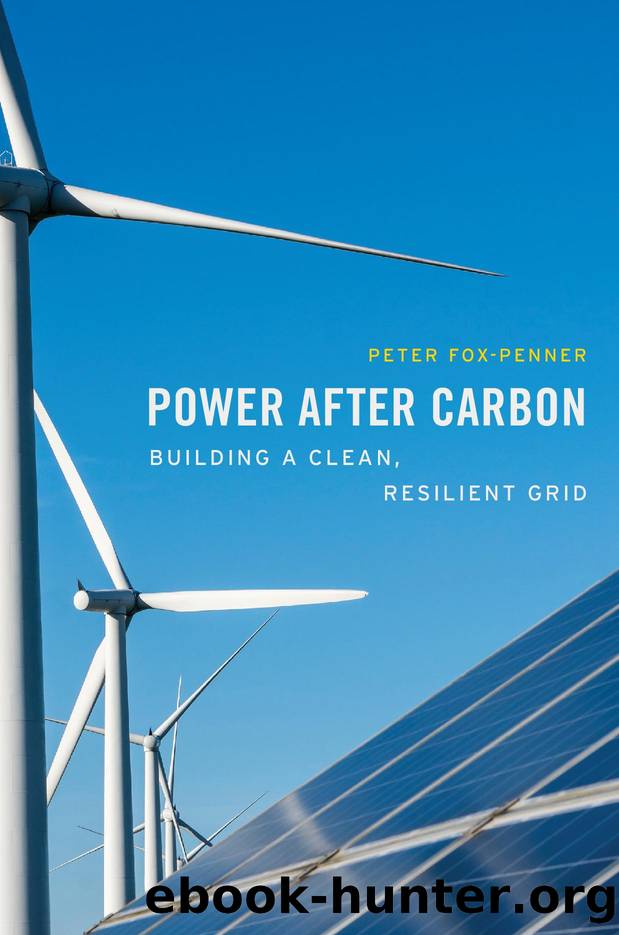Power after Carbon by Peter Fox-Penner

Author:Peter Fox-Penner
Language: eng
Format: epub
Publisher: Harvard University Press
The Problem of Fixed Costs
Collecting the portion of a utilityâs costs needed to make a utility whole, but which donât vary with its levels of sales, has vexed regulators and utilities since the birth of regulation. Over time, regulators and electric utilities have settled on a variety of approaches to recoup these revenues. They all have their pros and cons, and they are all going to get more complicated as the SI industry unfolds.
The primordial way to recoup fixed costs has been to add a margin to the price of delivering each kilowatt-hour and devote the accumulated margins toward fixed costs. In many delivery systems, the vast majority of revenues are still priced by taking all the costs of the utility, fixed and variable, and dividing by the number of kilowatt-hours sold. Since nearly all the costs of delivering power are fixed in the short run, much of this average price is in recovering fixed costs. In a typical $100 power bill, roughly $35â60 goes to the variable cost of actually making the power; the remainder is the largely fixed costs of transmission and distribution.17
As customer self-supply and grid defection become more common, this approach is going to have to change. When a prosumer installs their own power system, and supplies, say, two-thirds of their own kilowatt-hours, they then buy and pay for delivery of only one third of their former level of purchases. At the same per-kWh delivery charge, the SIâs delivery revenues have dropped by two thirds. But because the costs of serving that customer are fixed, the utility still needs the same level of revenue from that customer as it used to be earning to remain whole. In many places, the penetration of DG customers is low, and the revenue shortfall triggered by self-generation is small enough to patch over. In places such as California and Hawaii, where 5 and 30 percent of all homes already have solar, respectively, the revenue gap is too large to ignore.
There are a number of ways regulated prices can be changed to recapture the revenues lost when prosumers reduce their kWh use under volumetric rates. Regulators can add a fixed charge onto each customerâs bill or require a minimum monthly payment regardless of use, add a charge based on highest momentary (peak) use, or change per-kWh rates so they vary by time period or with total monthly use. In addition, they can use a variety of processes to readjust per-kWh rates more frequently.
There are several complicated and often conflicting aspects of each of these approaches. First, their effectiveness in reversing revenue shortfalls is often uncertain, incomplete, and situation specific. They vary greatly in the way they try to make prosumers who have reduced their kWh use still pay their fair share of fixed costs. They also vary in the way they treat customers who use little powerâgenerally (though not always) low-income and / or elderly households or small businessesâversus those who use a lot, and in the way they incentivize greater EE or DG use.
Download
This site does not store any files on its server. We only index and link to content provided by other sites. Please contact the content providers to delete copyright contents if any and email us, we'll remove relevant links or contents immediately.
The Secret History by Donna Tartt(18845)
The Social Justice Warrior Handbook by Lisa De Pasquale(12141)
Thirteen Reasons Why by Jay Asher(8793)
This Is How You Lose Her by Junot Diaz(6794)
Weapons of Math Destruction by Cathy O'Neil(6142)
Zero to One by Peter Thiel(5685)
Beartown by Fredrik Backman(5596)
The Myth of the Strong Leader by Archie Brown(5425)
The Fire Next Time by James Baldwin(5248)
How Democracies Die by Steven Levitsky & Daniel Ziblatt(5127)
Promise Me, Dad by Joe Biden(5087)
Stone's Rules by Roger Stone(5026)
A Higher Loyalty: Truth, Lies, and Leadership by James Comey(4843)
100 Deadly Skills by Clint Emerson(4840)
Rise and Kill First by Ronen Bergman(4702)
Secrecy World by Jake Bernstein(4644)
The David Icke Guide to the Global Conspiracy (and how to end it) by David Icke(4625)
The Farm by Tom Rob Smith(4435)
The Doomsday Machine by Daniel Ellsberg(4416)
